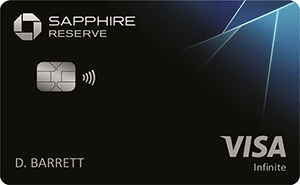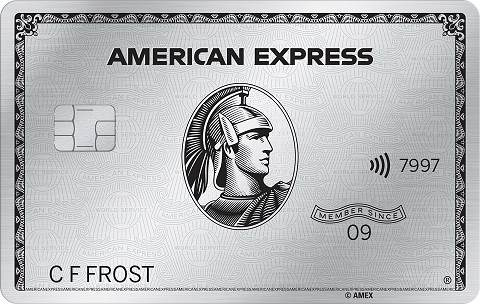AmEx Platinum vs. Chase Sapphire Reserve: Reserve Has More Mass Appeal
The Platinum Card from American Express might be the better option for traveling in style, but the Chase Sapphire Reserve is better for travel rewards and daily use.

Many or all of the products on this page are from partners who compensate us when you click to or take an action on their website, but this does not influence our evaluations or ratings. Our opinions are our own.
In the rarefied air of premium travel cards, two lead the pack when it comes to offering a chance for big rewards and a ton of travel benefits — for huge price tags. They are The Platinum Card® from American Express, with an annual fee of $695 (terms apply) and the Chase Sapphire Reserve® with an annual fee of $550.
These are cards for people willing to pay a lot because they expect a lot. Both cards offer generous rewards for travel, healthy welcome offers and a slew of benefits that make them hard to compare. But they have differences, both big and small.
In a head-to-head matchup, the better card will be the one that you, personally, can extract the most value from.
The Platinum Card® from American Express offers many perks for traveling in style. That’s why we think it’s suited to a certain type of traveler who appreciates better airport lounge options and hotel elite status, for example, as well as those simply partial to American Express. However, some of the card’s value is tied to niche retail offers, meaning most people are unlikely to use all of them.
The Chase Sapphire Reserve® is great for travel with sky-high point-earning and redemption value if you book through Chase. It also has wider appeal because of its higher rewards for restaurant spending. It comes with a big annual travel credit that is easy to use for even casual travelers.
That’s why, overall, the Chase card is probably the better choice for most people.
on Chase's website
on American Express' website
Earn 60,000 bonus points after you spend $5,000 on purchases in the first 3 months from account opening.
Earn 80,000 Membership Rewards® Points after you spend $8,000 on eligible purchases on your new Card in your first 6 months of Card Membership. Terms Apply. Terms apply.
10 points per dollar spent on hotel stays, car rentals and dining purchased through Chase. Also on Lyft through March 2025.
5 points per dollar spent on flights purchased through Chase.
3 points per dollar spent on other travel and dining worldwide.
1 point per dollar spent on all other purchases.
Note: Travel bonus rewards are after the first $300 is spent on travel purchases annually.
5 Membership Rewards points per dollar spent on flights booked directly with airlines or with American Express Travel.
5 points per dollar on prepaid hotels booked through American Express Travel.
2 points per dollar on other travel booked through AmEx.
1 point per dollar on all other purchases.
Terms apply (see rates and fees).
AmEx Platinum vs. Chase Sapphire Reserve: Deciding factors
The best card for you will be the one that better matches your spending and lifestyle. The Chase Sapphire Reserve® offers big value for its big annual fee. The Platinum Card® from American Express can also offer strong value, but you'll have to work harder to realize its full potential. If the card isn't a natural complement to a high-end lifestyle, it probably won't make sense. Here are some major factors to consider.
Welcome offer
Bonuses can change, so examine the current offers and the required spending. You’ll get big upfront value from both. Remember that points with the Chase Sapphire Reserve® can be worth 1.5 cents each when redeemed for travel booked through Chase. AmEx points can give outsized value too, but only when transferred to travel partners. (More on that later.)
Annual fee
The difference in annual fees — $695 vs. $550 — is $145, making The Platinum Card® from American Express 26% more expensive every year.
If you’re spending over $500 on a premium travel credit card, maybe an extra $145 per year isn’t a big deal. But if you’re comparing value, you’ll have to wring out more dollars from the AmEx card.
Travel bonus reward rates
With premium travel cards, rewards are key for buying plane tickets, hotel nights and other travel. The checkmark here goes to the Chase Sapphire Reserve®. Note that with both cards, some elevated rewards are only when you book travel through the issuer’s online travel portal.
Here’s a breakdown.
Chase Sapphire Reserve® | The Platinum Card® from American Express | |
|---|---|---|
10X rewards |
| None. |
5X rewards |
|
|
3X rewards |
| None. |
2X rewards | None. | Other travel booked through AmEx. |
The Chase Sapphire Reserve® has better rewards on hotel and car rentals booked through the issuer’s portal.
Just as important, the 3 points per dollar spent on all other travel is significant because the definition of travel is broad. That means earning extra points for not only obvious out-of-town travel-related expenditures but also local travel, including taxis, parking and tolls.
Restaurant rewards
Outside of travel, the Chase Sapphire Reserve® wins hands-down for its triple points on spending at restaurants, a useful bonus category even when you’re not jetting off somewhere. Add to that its 10 points per dollar spent on Chase Dining purchases when you make prepaid restaurant reservations, order takeout or join virtual cooking events through Chase.
The Platinum Card® from American Express has no bonus rewards for restaurants.
Redemption value
In this comparison of rewards rates, points aren’t necessarily equal with these cards.
Points with the Chase Sapphire Reserve® are worth 1.5 cents each when redeemed through Chase for travel — a reasonable redemption option to expect for people who use a premium travel card.
So if you’ll redeem points for travel on the Chase booking site, you can consider those bonus reward rates to be 50% more. For example, if you use the card to book a hotel stay or car rental through Chase travel, that 10x point-earning is suddenly worth 15x when those points are, in turn, redeemed for more travel. The 3x on restaurants is worth 4.5x for travel.
Generally, points with The Platinum Card® from American Express are worth 1 cent each (although, with both cards you could transfer to partners for possibly even more value. More on partners below.) Notably, if you redeem your Membership Rewards points for most hotel stays through AmEx Travel, they'll only be worth 0.7 cent a piece. That's less than half the value of the 1.5 cents you could get with Chase.
In addition, Chase has a program called Pay Yourself Back, in which points are also worth 50% more when you redeem them for statement credits against existing purchases in select, rotating categories or the annual membership fee. However, that redemption option is scheduled to end March 31, 2022. The deadline for using points for select charitable organizations is later, Dec. 31, 2022.
Travel credits
These are key benefits. When credits are used, they essentially help to cover part of the annual fee.
Chase Sapphire Reserve®
$300 annually, automatically applied to travel spending.
$120 maximum every four years for application to Global Entry, TSA PreCheck or NEXUS.
The Platinum Card® from American Express
$200 annually for airline incidentals, like bag fees.
$200 annually for prepaid hotel bookings through American Express Travel at more than 1,700 hotels. (Fine Hotels + Resorts or The Hotel Collection properties.)
$199 annually for Clear membership.
Fee credit for either Global Entry or TSA Precheck.
Terms apply. Enrollment is required.
The Chase Sapphire Reserve® probably has the edge for most people despite having fewer credits.
Why?
Its $300 credit is very easy to use on a wide range of travel. Credits on The Platinum Card® from American Express are narrower, making them harder to fully use every year.
Airport lounge access
The Platinum Card® from American Express gives access to American Express' own well-regarded Centurion Lounges, as well as Delta Sky Clubs and Airspace Lounges. You also get complimentary membership in Priority Pass Select when you enroll, which grants access to more than 1,300 airport lounges worldwide. Terms apply.
The offering is sparse by comparison for the Chase Sapphire Reserve®. It offers only Priority Pass Select membership. The American Express card wins handily, especially for Delta Air Lines flyers, when it comes to seeking refuge from the usual commotion at the boarding gates.
Though both cards offer Priority Pass, not all memberships are created equal. The Chase Sapphire Reserve® offers credit at Priority Pass-affiliated restaurants in more than 20 airports, but The Platinum Card® from American Express does not.
Hotel status
If you’re getting a luxury card because you expect preferred treatment at hotels, The Platinum Card® from American Express is the better choice. It offers complimentary Gold elite status when you enroll with two massive hotel chains, Hilton and Marriott, which gives you bonus points on each stay, plus other perks like complimentary Wi-Fi. Terms apply and enrollment is required. Chase offers some amenities from hotels in its The Edit by Chase Travel℠ (formerly the Luxury Hotel & Resort Collection), but offers no hotel elite status with a major chain.
Transfer partners
Tough call here because it depends on which transfer partners you prefer, based on what airlines and hotel companies you use. Compare these lists to see which partners appeal more to you.
Card ecosystem
If you’re considering one of these cards, you might be willing and savvy enough to use multiple credit cards to optimize rewards within the American Express Membership Rewards program or the Chase Ultimate Rewards® program. They’re both good programs, so this might hinge on cards you already have. For example, Chase has a suite of cards that work well together. Meanwhile, the American Express® Gold Card, with high rewards on restaurants and U.S. supermarkets, dovetails nicely with The Platinum Card® from American Express — although that’s a pricier combination.
Chase Sapphire Reserve vs. AmEx Platinum: Minor features to consider
Both cards offer a slew of travel and purchasing protections.
For example, while both have car-rental perks, the Chase Sapphire Reserve® offers primary rental car insurance, meaning you might not have to use your personal auto insurance.
On the other hand, The Platinum Card® from American Express offers complimentary cell phone protection. Terms apply. When you use the card to pay your monthly cell phone bill, you're eligible for up to $800 per year for two approved claims to cover repairs or replacement for your damaged or stolen phone. You'll pay a $50 deductible. The Chase Sapphire Reserve® offers no such protection.
If you want to go further down the tiebreaker list, you can get into niche perks, some with specific retailers:
Chase Sapphire Reserve® | The Platinum Card® from American Express | |
|---|---|---|
Other benefits |
|
|
Credit required
Neither card is appropriate for someone with poor credit. But they differ in the credit score ranges that will be accepted.
Chase Sapphire Reserve®: Your credit should be firmly in the excellent range (above 720) before you apply for this card. If you've opened five credit cards in the past 24 months, Chase may reject your application.
The Platinum Card® from American Express: This card is available to a wider range of applicants. Credit needs only to be good, not excellent, to have a reasonable chance of approval.
NerdWallet offers readers a chance to get pre-qualified for certain cards, which may entitle you to a better welcome offer.
Overseas acceptance
American Express cards are widely accepted, but less so abroad. The Visa network, which the Chase Sapphire Reserve® runs on, has near-universal acceptance where you can use payment cards.
Who might prefer AmEx Platinum over Chase Sapphire Reserve
Viewed solely as a premium travel card, The Platinum Card® from American Express might offer more luxury travel perks, along with considerable value, especially if you can take advantage of its niche offers. It should, because its annual fee is considerably higher.
But for most people, the Chase Sapphire Reserve® is probably the best premium credit card for spending on travel and for earning rewards toward even more travel.
1.5%-5%
Cashback$250
1x-5x
Points100,000
Points1%-5%
Cashback$200
Find the right credit card for you.
Whether you want to pay less interest or earn more rewards, the right card's out there. Just answer a few questions and we'll narrow the search for you.






